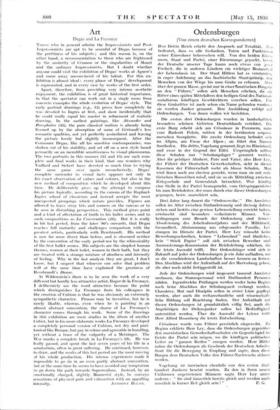Art
Degas and La Fresnaye
THOSE who in general admire the Impressionists and Post- Impressionists are apt to be scornful of Degas because of the prettiness of his subjects ; and this reason is, on the
other hand, a recommendation to those who are frightened by the austerity of Cezanne or the singularities of Monet and the ordinary Impressionists. But I doubt whether anyone could visit the exhibition of Degas' works at Agnew's is represented, and in every case by works of the first order.
Apart, therefore, from providing very intense aesthetic enjoyment, the exhibition is of great historical importance, in that the spectator can work out in a single room from
concrete examples the whole evolution of Degas' style. The early portrait drawings (e.g., 12) prove how completely he
was devoted to Ingres at first, and show incidentally that
he could really equal his master in refinement of realistic drawing. In the earliest paintings, like Alexander and Burephalus (33), the pure classical realism is already being
livened up by the absorption of some of Gericault's less romantic qualities, not yet perfectly assimilated and leaving the picture lovely but slightly inconsequent. After the Onumune Degas, like all his sensitive contemporaries, was shaken out of his stability, and set off on a new style based primarily on an incredible sensitiveness to visual phenomena. The two portraits in this manner (35 and 13) are such com- plete and final works in their kind, that one wonders why Vuillard and Sickert have devoted so much time to trying the same game over again inconclusively. Degas' complete surrender to visual facts appears not only in his exact observation of values and colours, but also in the
new method of composition which he developed about this time. He deliberately gives up the attempt to compose his picture logically, according to the canons of the Raphael- Ingres school of classicism and instead accepts the most unexpected groupings which nature provides. Figures are allowed to leave stray bits and corners on the canvas or to be seen in disturbing perspective. This method gives point and a kind of affectation of truth to his ballet scenes and to such compositions as La Conversation (26). But it is really in his last period, from the later '80's onwards, that Degas readies full maturity and Challenges comparison with the greatest artists, particularly with Rembrandt. His method is now far more direct than before, and is obscured neither by the convention of the early period nor by the whimsicality of the first ballet scenes. His subjects are the simplest human themes, women at their toilet, women in their bath, but they are treated with a strange mixture of aloofness and intensity of feeling. Why in the last analysis they are great, I don't know, but I suspect that whoever can solve that problem will at the same time have explained the greatness of Rembrandt's Danne.
At Wildenstein's there is to be seen the work of a very different but hardly less attractive artist, Roger de In Fresnaye. I deliberately use the word attractive because the point which distinguishes La Fresnaye from his colleagues in the creation of Cubism is that he was obviously an extremely sympathetic character. Picasso may be inventive, but he is rarely likable, whereas, even when he is painting in an almost abstract convention, the charm of La Fresnaye's character conies through his work. Some of the drawings in this exhibition are mere studies in. the idiom of another Cubist, but in his more elaborate works La Fresnaye developed a completely personal version of Cubism, not dry and puri- tanical like Braque, but gay in colour and agreeable in handling, yet without a trace of the vulgarity of a Metzinger. The War marks a complete break in La Fresnaye's life. He was badly gassed, and spent the last seven years of his life in a sanatorium, often in great suffering. He continued, however, to draw, and the works of this last period are the most moving of his whole. production. His intense experiences made it impossible to go on in an even partly abstract convention, but at the same time he seems to have.avoided any temptation to go down the path towards Superrealism. ,Instead, by an emotionally charged, slightly Mannerist style, he conveys sensations of physical pain and exhaustion with an appalling






















































 Previous page
Previous page